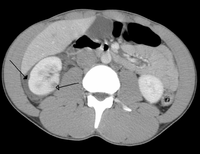
Photo from wikipedia
Outcomes after pancreatic trauma are directly related to the presence of main pancreatic duct injury. This study demonstrates that injury mechanism is an independent predictor of outcomes. BACKGROUND The impact… Click to show full abstract
Outcomes after pancreatic trauma are directly related to the presence of main pancreatic duct injury. This study demonstrates that injury mechanism is an independent predictor of outcomes. BACKGROUND The impact of injury mechanism on outcomes of pancreatic trauma has not been well studied, and current guidelines do not differentiate recommendations for blunt and penetrating injuries. The purpose of this study was to analyze interventions and outcomes as they relate to mechanism. We hypothesized that penetrating pancreatic trauma results in greater morbidity than blunt trauma because of more frequent operative exploration without imaging and thus more aggressive surgical management. METHODS Secondary analysis of a multicenter retrospective review of pancreatic injuries in patients 15 years and older from 2010 to 2018 was performed. Deaths within 24 hours of admission were excluded from analysis of the primary outcome, pancreas-related complications (PRCs). Data were analyzed by injury mechanism using various statistical tests where appropriate. RESULTS Thirty-three centers reported on 1,240 patients (44% penetrating). Penetrating trauma patients were twice as likely to undergo resection (45% vs. 23%) and suffer PRCs (39% vs. 20%). However, differences varied widely based on injury grade and management. There were fewer resections and more nonoperative management in blunt grades I to III injury. Pancreas-related complications occurred in 40% of high-grade injuries with no difference between mechanisms and in 40% of patients after resection, regardless of mechanism or injury grade. High-grade pancreatic injury (odds ratio [OR], 2.39; 95% confidence interval [CI], 1.55–3.67), penetrating injury (OR, 1.99; 95% CI, 1.31–3.05), and management in a low-volume center (i.e., five or fewer cases/year) (OR, 1.65; 95% CI, 1.16–2.35) were independent predictors of PRCs. CONCLUSION Management of grades I to III, but not grades IV/V, pancreatic injuries varies based on mechanism. Penetrating injury is an independent risk factor for PRCs, but main pancreatic duct injury and resection are associated with high rates of PRCs regardless of the injury mechanism. Resection appears to offer better outcomes for grade IV/V injuries, and grade I and II injuries should be managed nonoperatively. LEVEL OF EVIDENCE Therapeutic/Care Management; Level III.
Journal Title: Journal of Trauma and Acute Care Surgery
Year Published: 2022
Link to full text (if available)
Share on Social Media: Sign Up to like & get
recommendations!